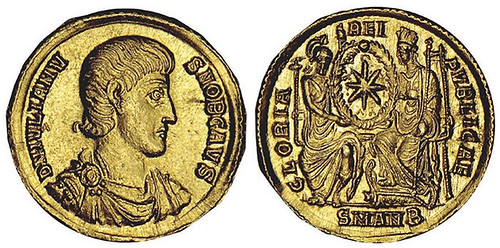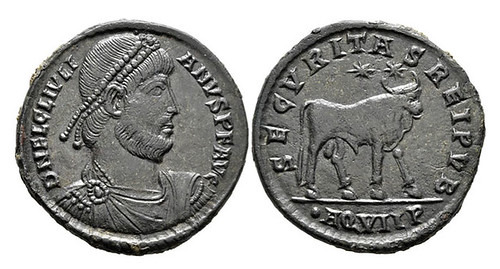
In his CoinWeek Ancient Coin Series, Mike Markowitz recently discussed the coinage of Julian the Apostate. Here's an excerpt - see the complete article online for much more.
-Editor
 REMEMBERED AS THE
REMEMBERED AS THE Apostate by his enemies, and the Philosopher by his friends, Flavius Claudius Julianus–or Julian–ruled as Roman emperor from November 3, 361 CE until his death on June 26, 363. On the list of emperors, he is numbered as Julian II , because a short-lived usurper, Julian of Pannonia, who briefly held power on the Danube frontier (c. 283-286), counts as Julian I .
In the massacre of Constantine the Great's relatives that followed his death in 337, Julian's father and many of his kin were slain. Julian and his half-brother Gallus were spared only because of their young ages: Julian was five years old; Gallus was about 10. Our future emperor spent much of his youth under a kind of house arrest at a remote estate in Cappadocia in Anatolia (modern Turkey), closely monitored by agents of his cousin, the paranoid emperor Constantius II. Brought up by his tutors as an orthodox Christian, Julian received an excellent classical education.
Julian as Caesar
In November 355, faced with a shortage of trustworthy generals and an abundance of invading barbarians, Constantius promoted Julian to the rank of Caesar (in effect, Junior Emperor) and put him in charge of defending Gaul. Despite his lack of military and political experience, Julian proved to be a gifted commander and a competent administrator. Julian's coinage as Caesar shows him clean-shaven in accordance with the current fashion of Constantius's court. Beards were considered a Greek affectation.

Julian II (Caesar, 355-361). Solidus. Antioch, c. 355-361. D N IVLIANV S NOB CAVS (instead of CAES). Diademed, draped and cuirassed bust r. Rv. GLORIA REI PVBLICAE. Roma and Constantinopolis, with foot on prow, and Roma enthroned to front, supporting between them shield inscribed with * and four small ×; in exergue, SMANB. AV 4.45 grams, 12h. RIC VIII, 166 var; Depeyrot 9/2 var. About Extremely Fine. (6,500-7,500). Stack's (pre-Feb 2011) > Moneta Imperii Romani Byzantini 12 January 2009. Lot: 3012. Realized: $7,000.
Probably the most popular and famous coin of Julian–and one of the few coin types referenced in ancient literary sources–is the large bronze follis, or double maiorina bearing the image of a bull on the reverse. Though ironically, numismatists don't know what the denomination was actually called, either by the people who issued it or the people who used it. Struck at most of the imperial mints, the coin weighs about 8.5 grams.
To read the complete article, see:
CoinWeek Ancient Coin Series: Julian the Apostate
(https://coinweek.com/ancient-coins/coinweek-ancient-coin-series-julian-the-apostate/)
Wayne Homren, Editor
The Numismatic Bibliomania Society is a non-profit organization
promoting numismatic literature. See our web site at coinbooks.org.
To submit items for publication in The E-Sylum, write to the Editor
at this address: whomren@gmail.com
To subscribe go to: https://my.binhost.com/lists/listinfo/esylum
Copyright © 1998 - 2024 The Numismatic Bibliomania Society (NBS)
All Rights Reserved.
NBS Home Page
Contact the NBS webmaster
|





